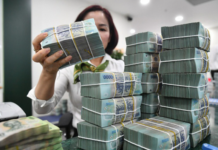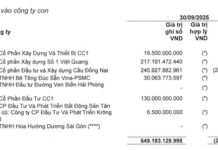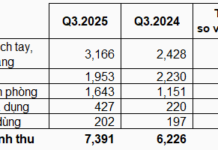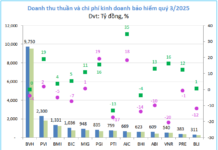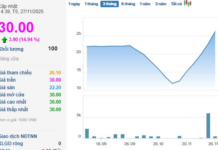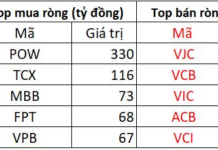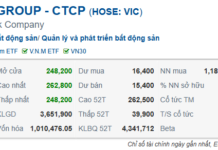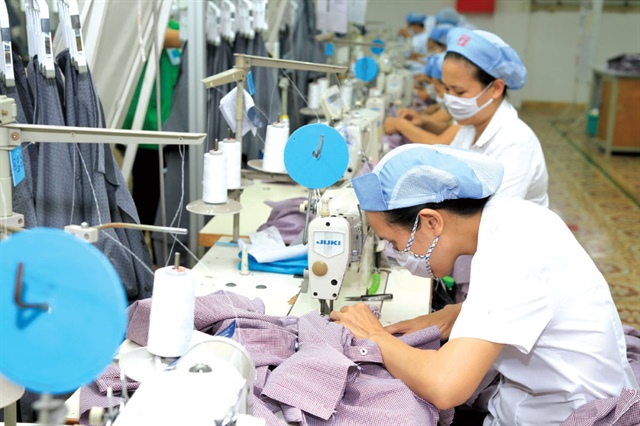
The US’s decision to impose high tariffs on Indian textiles opens opportunities for Vietnam to increase orders and expand its market share. Photo: T.L |
A range of India’s export industries are struggling due to the recent developments in US-India trade relations.
On August 6, 2025, former US President Donald Trump announced a 25% additional tariff on imports from India, effective August 27. Combined with the existing base tariff rate of 25%, some Indian goods entering the US now face a total tariff of up to 50%. According to statistics, about 80% of India’s export value to the US, amounting to $64 billion, is affected by these tariffs, causing Indian goods to lose their competitive edge in the US market.
However, with exports to the US accounting for only about 2% of India’s GDP, policymakers are not overly concerned. India has a diverse network of trade partners and does not rely heavily on trade like some other Asian countries.
Nevertheless, the negative impact will be significant for industries with large exports to the US. The textile industry is a prime example. In the 2023-2024 financial year, the US accounted for nearly 28% (approximately $10 billion) of India’s total textile exports of $36 billion. With the new tariff rates, many companies have had to postpone or cancel orders during the peak season, resulting in considerable losses.
In key textile-producing regions such as Tamil Nadu, Maharashtra, and Ludhiana (Punjab), many factories have had to temporarily halt operations after receiving order cancellations from the US. Businesses fear a decline in competitiveness, leading to a potential loss of over 28% of their export market share for woolen fabrics in the US.
The new tariff policy has also put pressure on the footwear industry, mainly based in Tamil Nadu. Manufacturers are facing increased costs and declining orders. This has led to concerns among investors participating in the “Make in India” program, including international brands such as Nike, Puma, Crocs, and Adidas, who are now reconsidering their production strategies in India.
The jewelry and gemstone industry, one of India’s traditional export strengths, is also facing significant challenges. In the special economic zones (SEZs) of Jaipur, the increased tariff rate to 50% has almost halted orders from the US just before the festive season, putting approximately 35,000 jobs at risk if the situation persists.
Moreover, the additional tariffs have severely impacted exports of components and parts, particularly those that the US imports from India. The level of impact on this group of products is predicted to be on par with that of the textile and jewelry industries.
Sectors like information technology services, mobile phones, pharmaceuticals, and oil, which are not related to Russia, have not been included in the tariff list so far. However, given the escalating tensions, businesses remain vigilant about the possibility of the US adjusting the exemption list in the future, especially with bilateral relations at their lowest point in years.
The “Mission 500” trade agreement between the two countries is now in jeopardy. Additionally, several defense procurement plans by India, including Stryker armored vehicles, Javelin missiles, and Boeing aircraft, have been delayed or slowed down until the tariff situation is clarified.
The tariffs have also impacted India’s financial market, with the rupee facing strong depreciation pressure against the US dollar, leading to exchange rate fluctuations and risks of capital outflows in the coming months. Within just one month, the rupee has lost more than 8.3% of its value against the dollar. Furthermore, the US’s secondary tariffs on India set a worrying precedent, indicating that Washington could take similar action against other countries, such as Brazil, if they continue to import oil from Russia.
Vietnam: Opportunities and Risks in Market Share
As mentioned, India has been one of the largest suppliers of textiles to the US market, especially in cotton clothing, knitwear, footwear, and handbags. The high tariffs will significantly increase the prices of these products, creating opportunities for Vietnam, another leading provider of textiles to the US, to increase its orders and expand its market share. This advantage is even more pronounced for Vietnamese factories that already have the required origin certification to meet the standards set by US trade agreements.
India is also a significant exporter of wooden furniture and handicrafts to the US, while Vietnam is among the top three exporters of wooden furniture to the same market. This presents an opportunity for Vietnamese businesses to secure more contracts and utilize their production capacity in major wood processing centers such as Binh Duong, Dong Nai, and Binh Dinh.
In the jewelry sector, India has long been a global hub for diamond and gemstone cutting and polishing. However, Vietnam can capitalize on niche segments like silver and lightweight gold jewelry, where domestic production and design capabilities are constantly improving.
Regarding seafood, India is the world’s largest exporter of shrimp, with the US as its primary market. Most of India’s frozen shrimp and prawns exported to the US are already subject to anti-dumping (AD) and countervailing duties (CVD). This industry is vulnerable if included in the new tariff list. However, it is unclear whether the US has imposed additional tariffs on India’s seafood exports.
If the US-India tensions escalate further due to New Delhi’s continued oil imports from Russia, Washington might impose tariffs on India’s seafood industry. Such a move would deal a severe blow to India’s seafood exports while presenting a significant opportunity for Vietnam. In this scenario, Vietnam’s shrimp exports to the US, especially processed whiteleg shrimp and value-added shrimp products, could surge.
Even if Indian seafood is exempt from the additional tariffs, as is the case with pharmaceuticals, some US importers may proactively diversify their supply sources to mitigate policy risks. With the increasing demand for stable and transparent supply chains, Vietnam is highly regarded for meeting stringent food safety standards.
However, Vietnam’s shrimp farming industry still relies partly on imports of shrimp breeds, feed, and biological products from India. If India’s exports are hindered, they might increase sales to Vietnam, driving down raw material prices. While this benefits processing enterprises, it puts considerable pressure on domestic farmers. Additionally, if the US tightens its imports from India, countries like Ecuador and Indonesia could also gain market share, thus sharing the “opportunity” with Vietnam.
India is also a crucial supplier of cotton, yarn, and dyes to many Vietnamese textile factories. If India’s exports slow down, domestic raw material prices may decrease, reducing production costs but also potentially disrupting the supply of high-quality inputs and causing fluctuations in the supply chain.
Moreover, as Indian goods lose their competitiveness in the US market, they may redirect their exports to the EU, ASEAN, and Middle Eastern markets, which are also key destinations for Vietnamese exports, thus intensifying price competition.
Another risk lies in the possibility of the US tightening its control over the origin of goods. If Indian enterprises utilize Vietnam as a transit point to avoid tariffs, Vietnamese exports may face stricter US inspections for rules of origin. To avoid this scenario, Indian companies, particularly in the textile and footwear sectors, may consider setting up factories in Vietnam to meet origin requirements and avoid US tariffs. In fact, Vietnam has already been a significant recipient of Indian FDI in recent years in sectors like pharmaceuticals, chemicals, and information technology, and this trend is likely to accelerate in the future.
Tuệ Nhiên
– 07:00 26/08/2025









